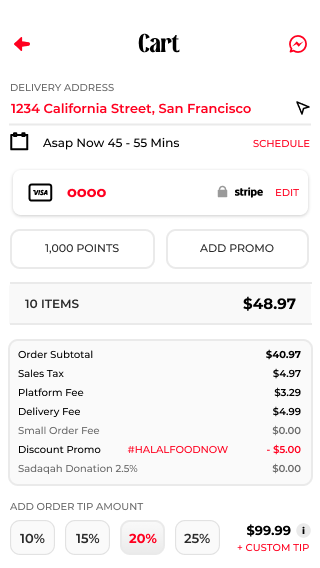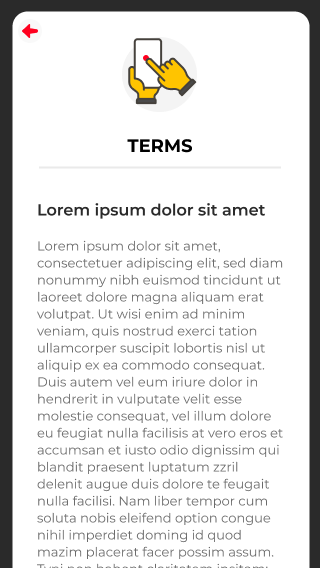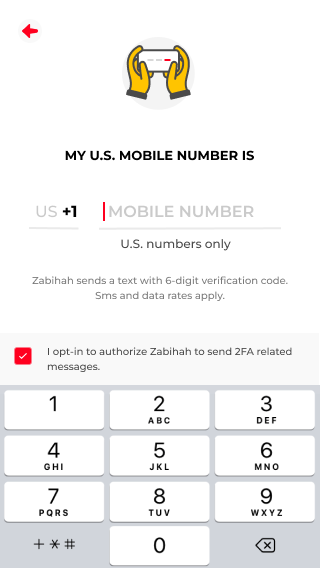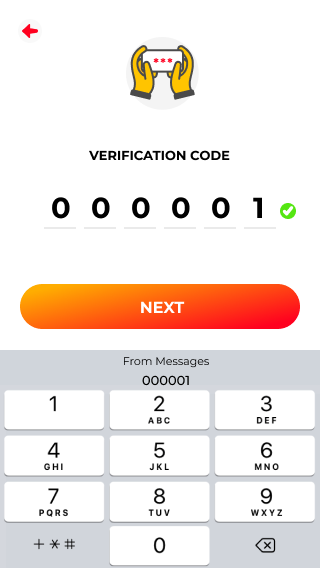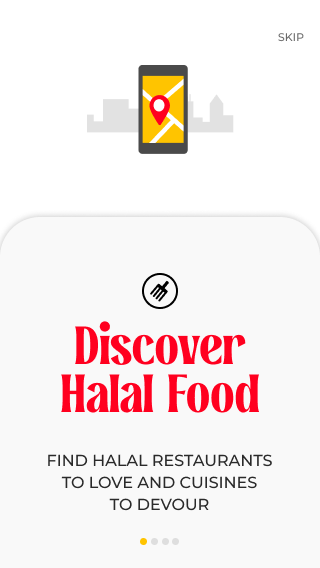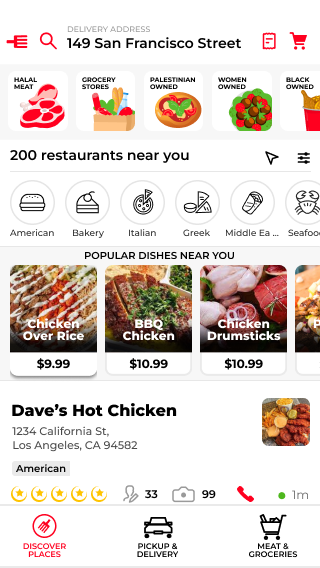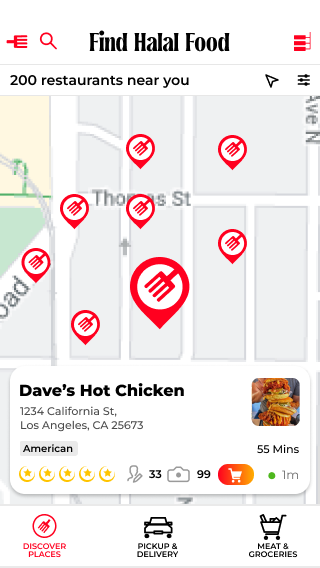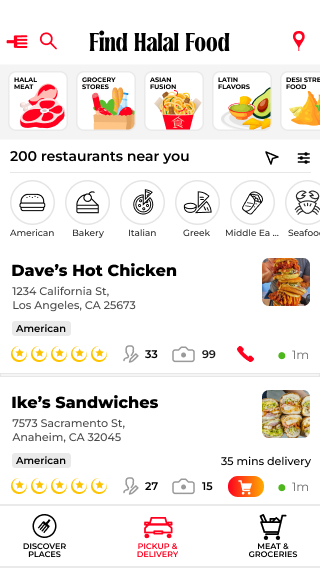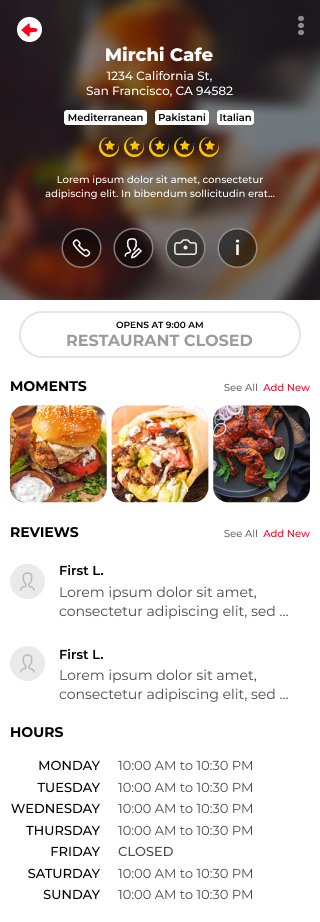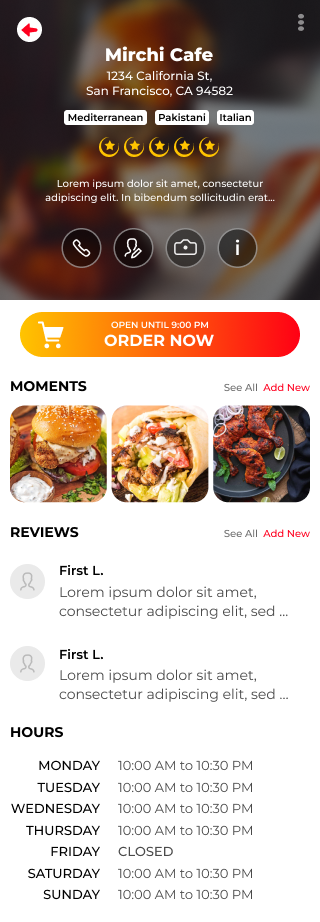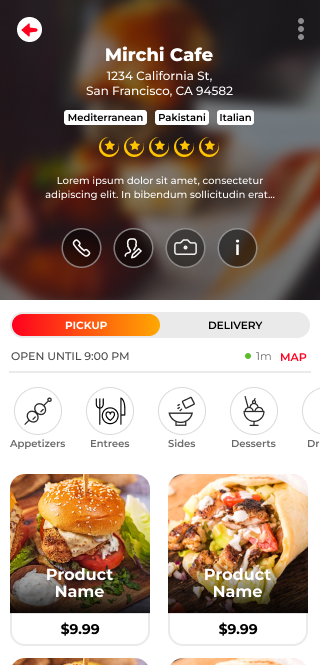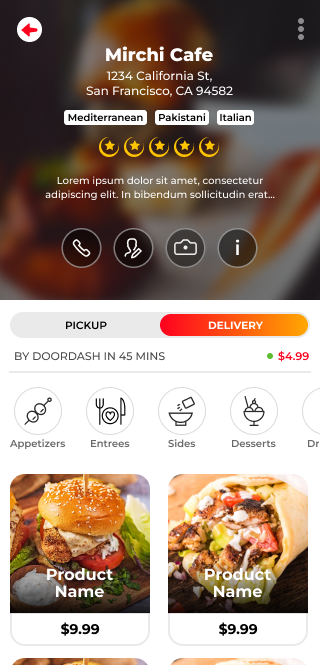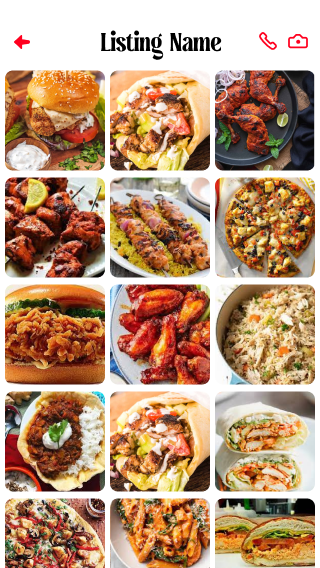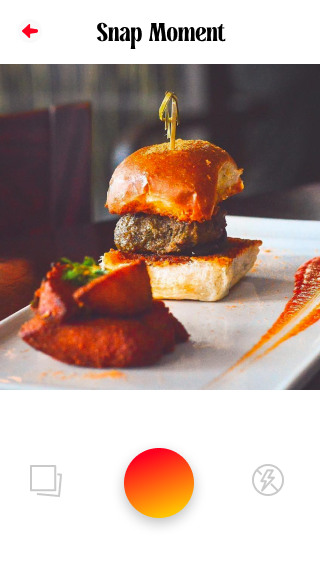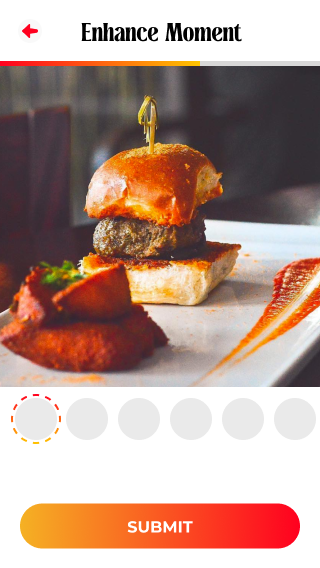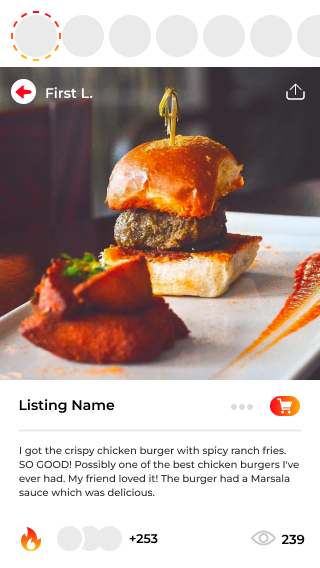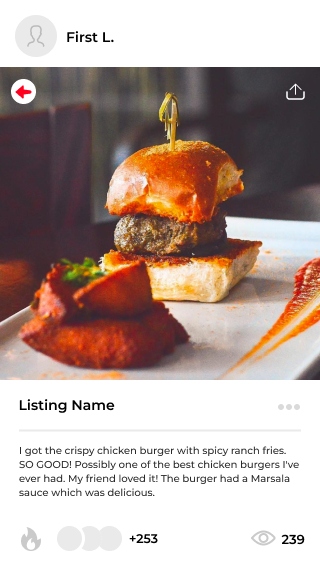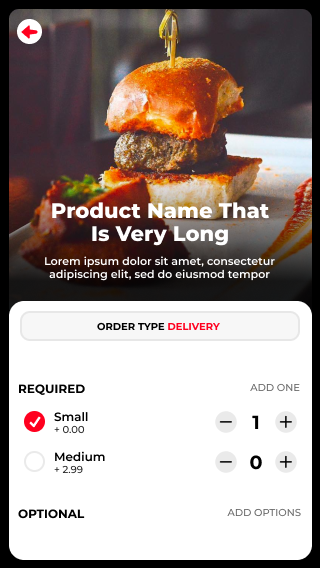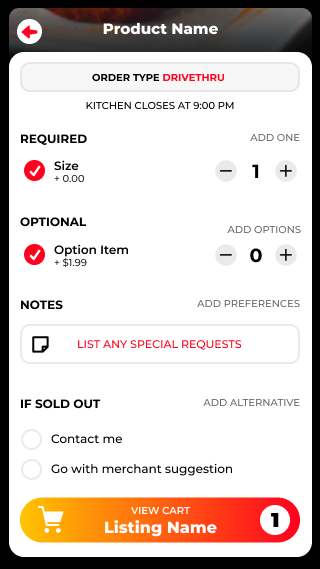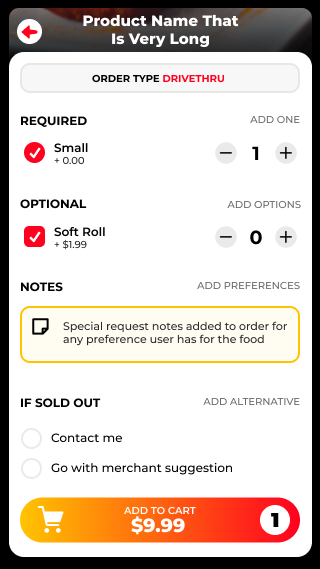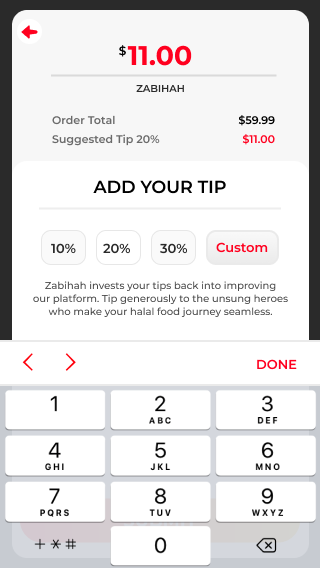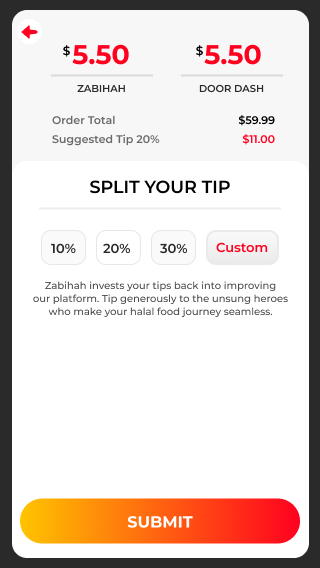{ roi }
Work Impact
300%
Higher Cart Sizes Than 3PP
$270.73
Customer Quarterly Spend
$940.93
Customer LTV Rolling GMV
$58.42
Average Ticket Regular Orde
$79.22
Average Ticket DriveThru Orde
6.3
Customer Order Frequency
$0.00
Customer Acquisition Cost
63-78%
Profit Margin
35
Average Delivery Minutes
{ DELIVERABLES }
Mobile App Designs
{ DELIVERABLES }
Mobile App Designs
{ DELIVERABLES }
Product Prototypes
{ DELIVERABLES }
POS + Hardware Design
{ DELIVERABLES }
POS + Hardware Design
{ DELIVERABLES }
Motion Graphics
{ DELIVERABLES }
Motion Graphics
{ DELIVERABLES }
Iconography
{ DELIVERABLES }
Iconography
{ deliverables }
Customer Onboarding
- ●
- ●
Elevating SMB restaurants with SaaS marketplace, headless commerce & last-mile delivery
Elevating SMB restaurants with SaaS marketplace, headless commerce & last-mile delivery
I founded Urban Foody with a simple yet ambitious vision: to bring the delectable global halal flavors to local neighborhoods. As a food enthusiast and tech entrepreneur, I wanted to create a platform that not only satisfies appetites but also connects cultures through the shared love of food. The journey, however, was far from easy.
I designed the restaurant SaaS platform from the ground up, including both iOS and Android apps. Initially, the goal was to create a discovery app that would help users find halal restaurants and diverse cuisines in their area. Despite my passion and dedication, the MVP launch faced limited engagement, and user adoption was slower than expected. Users desired more than just discovering restaurants — they wanted convenience and a seamless experience.
Listening to their feedback, I made the pivotal decision to expand into a last-mile delivery marketplace, enhancing the platform to meet user demands. This transformation wasn't easy. It required reimagining the platform's capabilities, redesigning the user experience, and overcoming logistical hurdles. Yet, these struggles enriched the journey, making Urban Foody not just a platform but a movement to connect people through the universal language of food.
I founded Urban Foody with a simple yet ambitious vision: to bring the delectable global halal flavors to local neighborhoods. As a food enthusiast and tech entrepreneur, I wanted to create a platform that not only satisfies appetites but also connects cultures through the shared love of food. The journey, however, was far from easy.
I designed the restaurant SaaS platform from the ground up, including both iOS and Android apps. Initially, the goal was to create a discovery app that would help users find halal restaurants and diverse cuisines in their area. Despite my passion and dedication, the MVP launch faced limited engagement, and user adoption was slower than expected. Users desired more than just discovering restaurants — they wanted convenience and a seamless experience.
Listening to their feedback, I made the pivotal decision to expand into a last-mile delivery marketplace, enhancing the platform to meet user demands. This transformation wasn't easy. It required reimagining the platform's capabilities, redesigning the user experience, and overcoming logistical hurdles. Yet, these struggles enriched the journey, making Urban Foody not just a platform but a movement to connect people through the universal language of food.
The Changing Landscape
The Changing Landscape
The advent of food delivery apps such as DoorDash and UberEats completely changed the way consumers discover and engage with a diverse array of cuisines. These platforms revolutionized the dining experience by providing unparalleled convenience, allowing users to explore new restaurants and order their favorite meals with just a few taps on their smartphones. By aggregating a wide range of culinary options in one place, these apps made it easier than ever for consumers to experiment with different flavors and dining establishments without leaving the comfort of their homes.
Moreover, these food delivery giants significantly impacted local businesses by expanding their reach beyond traditional dine-in customers. Restaurants, both large and small, could now tap into a broader customer base, increasing their visibility and revenue streams. This symbiotic relationship between delivery apps and eateries fostered a dynamic food ecosystem where innovation and variety thrived. Consumers benefited from this expanded selection, enjoying access to an extensive menu of options that catered to various tastes and dietary preferences.
However, despite their success, DoorDash and UberEats primarily focused on mainstream markets, often overlooking niche segments with specific cultural and dietary needs. This gap presented an opportunity for platforms like Urban Foody to emerge, addressing the unique requirements of communities seeking halal-certified and culturally authentic dining options.
Urban Foody was designed to bridge this gap by connecting users with trusted halal restaurants in their local neighborhoods, ensuring that cultural and dietary preferences are seamlessly integrated into the modern food delivery landscape. By prioritizing inclusivity and cultural sensitivity, Urban Foody not only enhances the food discovery experience but also fosters a sense of community and trust among its diverse user base.
The advent of food delivery apps such as DoorDash and UberEats completely changed the way consumers discover and engage with a diverse array of cuisines. These platforms revolutionized the dining experience by providing unparalleled convenience, allowing users to explore new restaurants and order their favorite meals with just a few taps on their smartphones. By aggregating a wide range of culinary options in one place, these apps made it easier than ever for consumers to experiment with different flavors and dining establishments without leaving the comfort of their homes.
Moreover, these food delivery giants significantly impacted local businesses by expanding their reach beyond traditional dine-in customers. Restaurants, both large and small, could now tap into a broader customer base, increasing their visibility and revenue streams. This symbiotic relationship between delivery apps and eateries fostered a dynamic food ecosystem where innovation and variety thrived. Consumers benefited from this expanded selection, enjoying access to an extensive menu of options that catered to various tastes and dietary preferences.
However, despite their success, DoorDash and UberEats primarily focused on mainstream markets, often overlooking niche segments with specific cultural and dietary needs. This gap presented an opportunity for platforms like Urban Foody to emerge, addressing the unique requirements of communities seeking halal-certified and culturally authentic dining options.
Urban Foody was designed to bridge this gap by connecting users with trusted halal restaurants in their local neighborhoods, ensuring that cultural and dietary preferences are seamlessly integrated into the modern food delivery landscape. By prioritizing inclusivity and cultural sensitivity, Urban Foody not only enhances the food discovery experience but also fosters a sense of community and trust among its diverse user base.
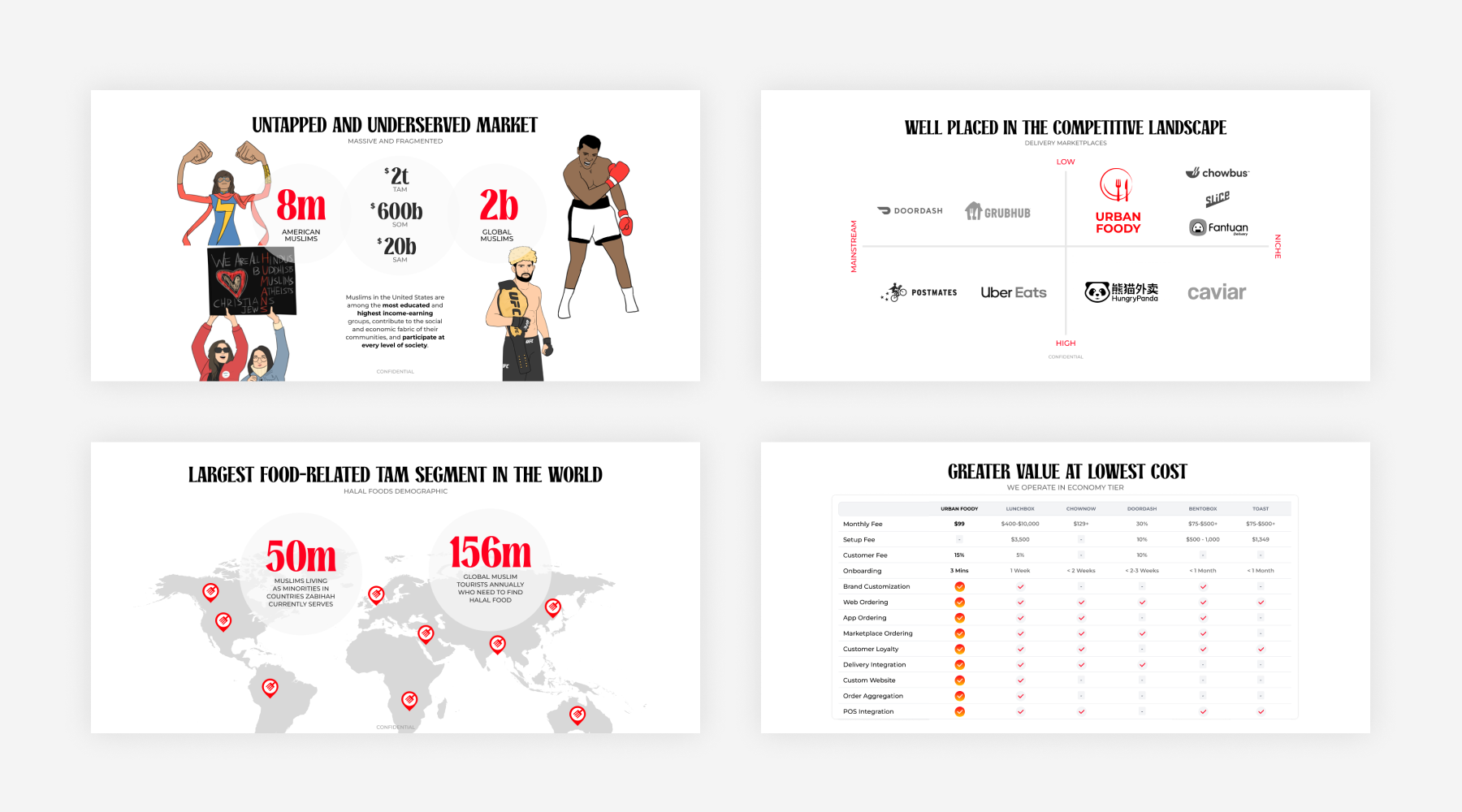
The Challenge
The Challenge
Launching Urban Foody presented several significant challenges that required innovative solutions. First, appealing to a culturally diverse audience was complex. I needed to create a platform that not only included halal food options but was also sensitive to various cultural nuances and dietary preferences. This was crucial to ensure inclusivity and attract a broad user base.
Second, the initial discovery app faced limited user engagement. Users wanted more than just discovering restaurants; they desired an engaging experience that motivated them to explore new cuisines and share their discoveries with others. Recognizing this, I needed to enhance the platform to better meet user expectations and increase engagement.
Lastly, building a robust technical infrastructure was essential. Designing a scalable and flexible API that could handle complex queries and integrate various services was critical for the platform's success. We needed to ensure seamless performance as we expanded our offerings to include last-mile delivery, similar to how Uber Eats manages complex logistics.
Launching Urban Foody presented several significant challenges that required innovative solutions. First, appealing to a culturally diverse audience was complex. I needed to create a platform that not only included halal food options but was also sensitive to various cultural nuances and dietary preferences. This was crucial to ensure inclusivity and attract a broad user base.
Second, the initial discovery app faced limited user engagement. Users wanted more than just discovering restaurants; they desired an engaging experience that motivated them to explore new cuisines and share their discoveries with others. Recognizing this, I needed to enhance the platform to better meet user expectations and increase engagement.
Lastly, building a robust technical infrastructure was essential. Designing a scalable and flexible API that could handle complex queries and integrate various services was critical for the platform's success. We needed to ensure seamless performance as we expanded our offerings to include last-mile delivery, similar to how Uber Eats manages complex logistics.
- Culturally Diverse Audience The platform needed to appeal to a broad spectrum of users, including those seeking halal food options, while being sensitive to cultural nuances and dietary preferences
- Enhanced Engagement The goal was to design an engaging experience that motivated users to explore new cuisines and share their discoveries
- Complex API Interactions Designing a robust API interface was essential to support the platform’s capability and scalability, ensuring seamless integration of various services and data sources.
- Culturally Diverse Audience The platform needed to appeal to a broad spectrum of users, including those seeking halal food options, while being sensitive to cultural nuances and dietary preferences
- Enhanced Engagement The goal was to design an engaging experience that motivated users to explore new cuisines and share their discoveries
- Complex API Interactions Designing a robust API interface was essential to support the platform’s capability and scalability, ensuring seamless integration of various services and data sources.
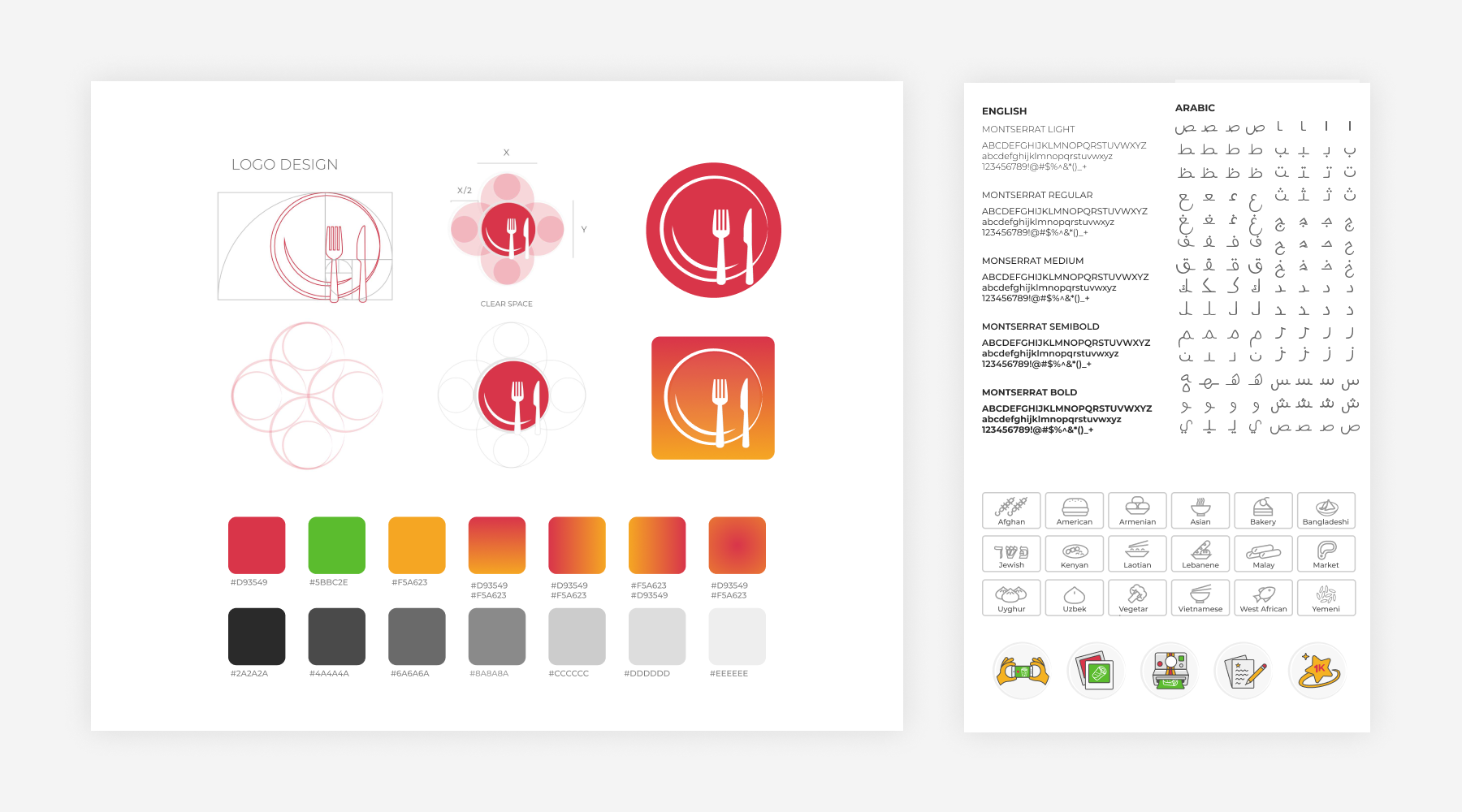
My Role
My Role
As the founder and principal product designer, I was responsible for shaping every aspect of Urban Foody’s design and development. From conceptualizing the initial design to leading the technical implementation, my role required a harmonious blend of creative vision and technical expertise. I spearheaded the hiring process, assembling a talented team that included a motion designer, data specialists, researchers, and engineers.
I conducted comprehensive user research, organizing interviews and surveys to gain deep insights into our target audience’s motivations and pain points. This research was pivotal in developing detailed user personas, which guided our design strategy and ensured that the platform addressed the real needs of our users. By immersing myself in the community, I gathered firsthand feedback that informed both the aesthetic and functional aspects of the app, ensuring a user-centric approach throughout the development process.
I led the design of the platform, focusing on creating an intuitive and culturally sensitive user experience. This included developing a global design system that ensured consistency across all touchpoints. Incorporating diverse cultural elements into the design ensured that the platform resonated with a wide audience.
Collaborating with developers, I ensured that the technical aspects of the platform aligned with our goals. This involved designing a scalable API and integrating complex features like real-time delivery tracking. Creating a flexible and robust API structure was crucial, as was implementing advanced functionalities seamlessly. Working closely with the development team allowed us to overcome technical challenges effectively.
As the founder and principal product designer, I was responsible for shaping every aspect of Urban Foody’s design and development. From conceptualizing the initial design to leading the technical implementation, my role required a harmonious blend of creative vision and technical expertise. I spearheaded the hiring process, assembling a talented team that included a motion designer, data specialists, researchers, and engineers.
I conducted comprehensive user research, organizing interviews and surveys to gain deep insights into our target audience’s motivations and pain points. This research was pivotal in developing detailed user personas, which guided our design strategy and ensured that the platform addressed the real needs of our users. By immersing myself in the community, I gathered firsthand feedback that informed both the aesthetic and functional aspects of the app, ensuring a user-centric approach throughout the development process.
I led the design of the platform, focusing on creating an intuitive and culturally sensitive user experience. This included developing a global design system that ensured consistency across all touchpoints. Incorporating diverse cultural elements into the design ensured that the platform resonated with a wide audience.
Collaborating with developers, I ensured that the technical aspects of the platform aligned with our goals. This involved designing a scalable API and integrating complex features like real-time delivery tracking. Creating a flexible and robust API structure was crucial, as was implementing advanced functionalities seamlessly. Working closely with the development team allowed us to overcome technical challenges effectively.
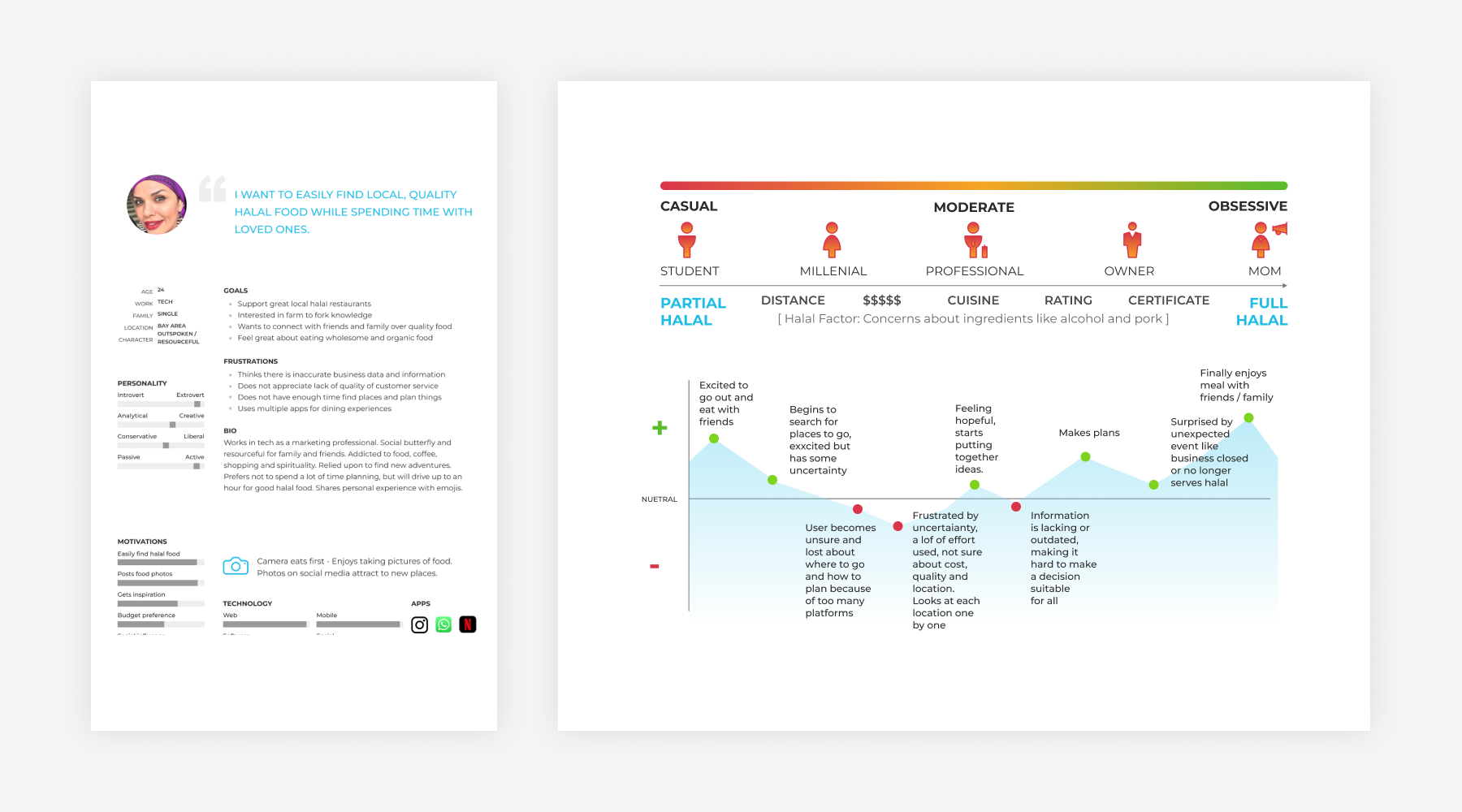
User Research and Persona Development
User Research and Persona Development
Understanding our customers required me to immerse deeply into their worlds. I ventured into local neighborhoods, engaged with restaurant owners, spent time inside their kitchens, and even followed delivery drivers on their routes.
Visiting restaurants in various cities to experience their food workplace cultures helped me understand the unique challenges and preferences in each location. Building relationships with local eateries and partnerships with service teams in the delivery ecosystem allowed me to identify pain points and areas for improvement.
By observing users interacting with the platform in real-life settings, I gained insights into how they used Urban Foody and where enhancements were needed. Watching users navigate the app while ordering food, seeing how restaurant staff interacted with our system during peak times, and gathering immediate reactions and suggestions from users were invaluable to the development process.
Additionally, mapping out the user journey allowed me to identify key emotional touchpoints and optimize the experience accordingly. From the initial discovery of a halal restaurant to the seamless completion of a delivery, every step was designed to be intuitive and satisfying. This approach ensured that Urban Foody provided a meaningful and enjoyable experience, fostering long-term loyalty and trust among our diverse user base.
Understanding our customers required me to immerse deeply into their worlds. I ventured into local neighborhoods, engaged with restaurant owners, spent time inside their kitchens, and even followed delivery drivers on their routes.
Visiting restaurants in various cities to experience their food workplace cultures helped me understand the unique challenges and preferences in each location. Building relationships with local eateries and partnerships with service teams in the delivery ecosystem allowed me to identify pain points and areas for improvement.
By observing users interacting with the platform in real-life settings, I gained insights into how they used Urban Foody and where enhancements were needed. Watching users navigate the app while ordering food, seeing how restaurant staff interacted with our system during peak times, and gathering immediate reactions and suggestions from users were invaluable to the development process.
Additionally, mapping out the user journey allowed me to identify key emotional touchpoints and optimize the experience accordingly. From the initial discovery of a halal restaurant to the seamless completion of a delivery, every step was designed to be intuitive and satisfying. This approach ensured that Urban Foody provided a meaningful and enjoyable experience, fostering long-term loyalty and trust among our diverse user base.
Cultural Sensitivity in Design
Cultural Sensitivity in Design
Cultural inclusivity was at the core of Urban Foody’s design philosophy. Recognizing that food is a significant aspect of cultural identity, I ensured that the platform celebrated and respected the diverse backgrounds of our users. This involved integrating a wide range of global cuisines and providing halal-certified options to cater to various dietary requirements. By prioritizing cultural sensitivity, Urban Foody became a trusted platform for users seeking authentic and reliable dining experiences.
I implemented a trustworthy and easy-to-use filtered search, ensuring that information was clear and consistent, providing them with confidence in their dining choices. Additionally, I incorporated diverse cultural elements into the design, using culturally relevant imagery, icons, and language to create a welcoming and inclusive environment for all users.
To enhance user engagement, I focused on the social aspects of dining. I integrated features that allowed users to share their dining experiences which not just improved user satisfaction but also reinforced the communal aspect of food.
Cultural inclusivity was at the core of Urban Foody’s design philosophy. Recognizing that food is a significant aspect of cultural identity, I ensured that the platform celebrated and respected the diverse backgrounds of our users. This involved integrating a wide range of global cuisines and providing halal-certified options to cater to various dietary requirements. By prioritizing cultural sensitivity, Urban Foody became a trusted platform for users seeking authentic and reliable dining experiences.
I implemented a trustworthy and easy-to-use filtered search, ensuring that information was clear and consistent, providing them with confidence in their dining choices. Additionally, I incorporated diverse cultural elements into the design, using culturally relevant imagery, icons, and language to create a welcoming and inclusive environment for all users.
To enhance user engagement, I focused on the social aspects of dining. I integrated features that allowed users to share their dining experiences which not just improved user satisfaction but also reinforced the communal aspect of food.
- Halal Food Discovery Users struggled with finding reliable halal food options due to inconsistent information and unclear certifications. URBAN FOODY aimed to bridge this gap by offering a trustworthy and easy-to-use filtered search.
- Social Dynamics Users frequently used social media and group chats to discover and plan dining experiences. The platform needed to facilitate easy sharing and collaboration among users.
- Halal Food Discovery Users struggled with finding reliable halal food options due to inconsistent information and unclear certifications. URBAN FOODY aimed to bridge this gap by offering a trustworthy and easy-to-use filtered search.
- Social Dynamics Users frequently used social media and group chats to discover and plan dining experiences. The platform needed to facilitate easy sharing and collaboration among users.

Designing the Platform
Designing the Platform
Building a robust API was critical to support Urban Foody’s expanded features, including last-mile delivery. I collaborated closely with our engineering team to design an API capable of handling complex queries and integrating seamlessly with various services. This involved creating a flexible and scalable API structure that could accommodate future growth and additional functionalities, ensuring the platform could adapt to evolving user needs and market trends.
To facilitate smooth integration, I presented detailed mockups and API schemas, including response bodies in JSON format. This collaborative design process fostered meaningful conversations between our teams, ensuring that the API not only met technical requirements but also enhanced the overall user experience. The API was designed to support real-time delivery tracking, dynamic restaurant listings, and personalized recommendations, positioning Urban Foody as a competitive player in the market.
Our API design focused on flexibility and scalability, enabling seamless performance as we expanded our offerings. By ensuring that the API could handle filtered searches based on cuisine types, halal certification, and user preferences, we provided users with a highly personalized and efficient food discovery and delivery experience. This technical foundation was essential for Urban Foody’s ability to grow and innovate continuously.
Building a robust API was critical to support Urban Foody’s expanded features, including last-mile delivery. I collaborated closely with our engineering team to design an API capable of handling complex queries and integrating seamlessly with various services. This involved creating a flexible and scalable API structure that could accommodate future growth and additional functionalities, ensuring the platform could adapt to evolving user needs and market trends.
To facilitate smooth integration, I presented detailed mockups and API schemas, including response bodies in JSON format. This collaborative design process fostered meaningful conversations between our teams, ensuring that the API not only met technical requirements but also enhanced the overall user experience. The API was designed to support real-time delivery tracking, dynamic restaurant listings, and personalized recommendations, positioning Urban Foody as a competitive player in the market.
Our API design focused on flexibility and scalability, enabling seamless performance as we expanded our offerings. By ensuring that the API could handle filtered searches based on cuisine types, halal certification, and user preferences, we provided users with a highly personalized and efficient food discovery and delivery experience. This technical foundation was essential for Urban Foody’s ability to grow and innovate continuously.

Developing the Design System
Developing the Design System
Creating a consistent and engaging user experience requires the establishment of a comprehensive design system, which I developed using Figma as our primary design tool. Leveraging Figma's powerful features, I built a library of reusable components that ensured uniformity across all platforms. By utilizing variables and design tokens, such as color palettes, typography scales, and spacing guidelines, I maintained consistency in visual elements while allowing for easy scalability and customization. This structured approach not only streamlined the design process but also facilitated seamless collaboration between our teams, ensuring that every element adhered to our established standards.
I meticulously crafted each component with Figma’s auto layout features, enabling responsive and adaptable designs that performed flawlessly across various devices and screen sizes. This included designing interactive elements like buttons, forms, and navigation menus that were both visually appealing and highly functional.
Additionally, I integrated motion graphics and transition animations to enhance user interactions, reducing cognitive load and making the platform more intuitive. By implementing design tokens, I ensured that any updates to the design system could be efficiently propagated throughout the entire application, maintaining a cohesive aesthetic and improving overall user experience.
Flexibility and adaptability were key considerations in developing the design system. I incorporated design tokens and variables that allowed for rapid iterations based on user feedback and evolving market trends. This agility was crucial during the pivot to a last-mile delivery marketplace, as it enabled quick adjustments to the user interface and user experience without compromising design integrity.
By maintaining a cohesive and visually appealing design across all touchpoints through Figma’s centralized system, Urban Foody provided a seamless and intuitive user experience. This approach not only fostered trust and engagement among users from diverse cultural backgrounds but also ensured that the platform could swiftly adapt to meet new challenges and opportunities.
Creating a consistent and engaging user experience requires the establishment of a comprehensive design system, which I developed using Figma as our primary design tool. Leveraging Figma's powerful features, I built a library of reusable components that ensured uniformity across all platforms. By utilizing variables and design tokens, such as color palettes, typography scales, and spacing guidelines, I maintained consistency in visual elements while allowing for easy scalability and customization. This structured approach not only streamlined the design process but also facilitated seamless collaboration between our teams, ensuring that every element adhered to our established standards.
I meticulously crafted each component with Figma’s auto layout features, enabling responsive and adaptable designs that performed flawlessly across various devices and screen sizes. This included designing interactive elements like buttons, forms, and navigation menus that were both visually appealing and highly functional.
Additionally, I integrated motion graphics and transition animations to enhance user interactions, reducing cognitive load and making the platform more intuitive. By implementing design tokens, I ensured that any updates to the design system could be efficiently propagated throughout the entire application, maintaining a cohesive aesthetic and improving overall user experience.
Flexibility and adaptability were key considerations in developing the design system. I incorporated design tokens and variables that allowed for rapid iterations based on user feedback and evolving market trends. This agility was crucial during the pivot to a last-mile delivery marketplace, as it enabled quick adjustments to the user interface and user experience without compromising design integrity.
By maintaining a cohesive and visually appealing design across all touchpoints through Figma’s centralized system, Urban Foody provided a seamless and intuitive user experience. This approach not only fostered trust and engagement among users from diverse cultural backgrounds but also ensured that the platform could swiftly adapt to meet new challenges and opportunities.
- Visual and Interaction Design Creating custom visuals and motion graphics that conveyed meaning and reduced cognitive load. The design elements were tailored to support a variety of global cuisines and user appetites.
- Color Science and Emoji Integration Leveraging color psychology, we used colors like red, yellow, and orange to evoke appetite and excitement. Emojis were incorporated to humanize the brand and add a layer of emotion to the content, aligning with the platform’s values of happiness, inclusion, transparency, and accountability.
- Visual and Interaction Design Creating custom visuals and motion graphics that conveyed meaning and reduced cognitive load. The design elements were tailored to support a variety of global cuisines and user appetites.
- Color Science and Emoji Integration Leveraging color psychology, we used colors like red, yellow, and orange to evoke appetite and excitement. Emojis were incorporated to humanize the brand and add a layer of emotion to the content, aligning with the platform’s values of happiness, inclusion, transparency, and accountability.

Implementing the Octalysis Framework
Implementing the Octalysis Framework
To drive user engagement and adoption, I applied the Octalysis framework, focusing on the core drives of human motivation. This strategic approach enabled the design of features that resonated with users on a psychological level, encouraging deeper interaction with the platform.
I introduced elements of social influence by highlighting trending restaurants and enabling users to share their dining experiences with friends and family. Scarcity and exclusivity were leveraged through limited-time offers and exclusive deals, creating a sense of urgency and desire among users. Unpredictability was incorporated with surprise recommendations and personalized suggestions, keeping the user experience fresh and exciting.
By providing users with a sense of accomplishment through progress tracking, reviews, and ratings, we fostered loyalty and repeat usage. This gamification of the platform made the user experience more enjoyable and engaging, encouraging users to actively participate and contribute to the community. The integration of these motivational elements ensured sustained user engagement and enhanced the overall appeal of Urban Foody.
To drive user engagement and adoption, I applied the Octalysis framework, focusing on the core drives of human motivation. This strategic approach enabled the design of features that resonated with users on a psychological level, encouraging deeper interaction with the platform.
I introduced elements of social influence by highlighting trending restaurants and enabling users to share their dining experiences with friends and family. Scarcity and exclusivity were leveraged through limited-time offers and exclusive deals, creating a sense of urgency and desire among users. Unpredictability was incorporated with surprise recommendations and personalized suggestions, keeping the user experience fresh and exciting.
By providing users with a sense of accomplishment through progress tracking, reviews, and ratings, we fostered loyalty and repeat usage. This gamification of the platform made the user experience more enjoyable and engaging, encouraging users to actively participate and contribute to the community. The integration of these motivational elements ensured sustained user engagement and enhanced the overall appeal of Urban Foody.
- Social Influence and Scarcity Encouraging users to explore trending restaurants and exclusive dining experiences.
- Unpredictability and Curiosity Keeping users engaged with features like random restaurant suggestions and surprise offers.
- Accomplishment and Empowerment Providing users with a sense of achievement through features like progress tracking, reviews, and ratings.
- Social Influence and Scarcity Encouraging users to explore trending restaurants and exclusive dining experiences.
- Unpredictability and Curiosity Keeping users engaged with features like random restaurant suggestions and surprise offers.
- Accomplishment and Empowerment Providing users with a sense of achievement through features like progress tracking, reviews, and ratings.

Iterating Quickly
Iterating Quickly
Speed and agility were essential in refining Urban Foody to meet user expectations and stay ahead in the competitive food delivery market. I adopted a rapid iteration approach, continuously testing designs in real-world settings and making swift improvements based on user feedback. This methodology allowed us to identify and address issues early, ensuring that the platform evolved in line with user needs and preferences.
Developing quick prototypes was a cornerstone of our iterative process. By creating mock-ups and wireframes, we could visualize new ideas and gather immediate feedback from users through user testing sessions. These sessions provided valuable insights into what worked well and what needed improvement, enabling us to refine features and enhance the overall user experience efficiently. This responsiveness ensured that we stayed aligned with user expectations and maintained high levels of satisfaction.
Implementing A/B testing further optimized our design decisions by allowing us to compare different versions of features and determine which resonated best with users. Analyzing performance metrics and making data-driven decisions ensured that we consistently rolled out the most effective solutions. Additionally, working in agile cycles facilitated continuous improvement, with sprint planning, collaborative workflows, and continuous deployment enabling the team to adapt quickly to changes and deliver updates regularly. This approach not only accelerated development but also fostered a culture of innovation and excellence within the team.
Speed and agility were essential in refining Urban Foody to meet user expectations and stay ahead in the competitive food delivery market. I adopted a rapid iteration approach, continuously testing designs in real-world settings and making swift improvements based on user feedback. This methodology allowed us to identify and address issues early, ensuring that the platform evolved in line with user needs and preferences.
Developing quick prototypes was a cornerstone of our iterative process. By creating mock-ups and wireframes, we could visualize new ideas and gather immediate feedback from users through user testing sessions. These sessions provided valuable insights into what worked well and what needed improvement, enabling us to refine features and enhance the overall user experience efficiently. This responsiveness ensured that we stayed aligned with user expectations and maintained high levels of satisfaction.
Implementing A/B testing further optimized our design decisions by allowing us to compare different versions of features and determine which resonated best with users. Analyzing performance metrics and making data-driven decisions ensured that we consistently rolled out the most effective solutions. Additionally, working in agile cycles facilitated continuous improvement, with sprint planning, collaborative workflows, and continuous deployment enabling the team to adapt quickly to changes and deliver updates regularly. This approach not only accelerated development but also fostered a culture of innovation and excellence within the team.

Innovating Constantly
Innovating Constantly
Innovation was the driving force behind Urban Foody’s evolution, enabling us to redefine the traditional food delivery model with unique features and services. Transitioning from a discovery app to a delivery marketplace opened new avenues for growth and user engagement. Implementing our own last-mile delivery system provided greater control over the delivery process, ensuring reliability and efficiency for our users.
I integrated advanced technologies to enhance functionality and user satisfaction. Personalization was employed through cuisine options based on user preferences and past behaviors, making the discovery process more intuitive and tailored. Interactive maps were developed to help users and delivery partners navigate more effectively, reducing delivery times and improving overall efficiency. Seamless payment integrations simplified transactions, providing a smooth and secure experience for users.
Fostering a sense of community among users, restaurants, and delivery partners was key to our success. Features that enabled users to share reviews, connect with others, and collaborate with local businesses helped build a vibrant and engaged community around Urban Foody. Additionally, hosting activities that celebrate diversity and food further reinforced our commitment to cultural inclusivity and community building. These continuous innovations not only enhanced the user experience but also positioned Urban Foody as a leader in the niche market of halal food discovery and delivery.
Innovation was the driving force behind Urban Foody’s evolution, enabling us to redefine the traditional food delivery model with unique features and services. Transitioning from a discovery app to a delivery marketplace opened new avenues for growth and user engagement. Implementing our own last-mile delivery system provided greater control over the delivery process, ensuring reliability and efficiency for our users.
I integrated advanced technologies to enhance functionality and user satisfaction. Personalization was employed through cuisine options based on user preferences and past behaviors, making the discovery process more intuitive and tailored. Interactive maps were developed to help users and delivery partners navigate more effectively, reducing delivery times and improving overall efficiency. Seamless payment integrations simplified transactions, providing a smooth and secure experience for users.
Fostering a sense of community among users, restaurants, and delivery partners was key to our success. Features that enabled users to share reviews, connect with others, and collaborate with local businesses helped build a vibrant and engaged community around Urban Foody. Additionally, hosting activities that celebrate diversity and food further reinforced our commitment to cultural inclusivity and community building. These continuous innovations not only enhanced the user experience but also positioned Urban Foody as a leader in the niche market of halal food discovery and delivery.

Testing and Validation
Testing and Validation
Ensuring that Urban Foody met the highest standards of usability and functionality required rigorous testing and validation processes. I prioritized collecting comprehensive feedback from users and making data-driven improvements to refine the platform continuously. This commitment to quality assurance was essential in building a reliable and trustworthy app that users could depend on for their food discovery and delivery needs.
Extensive user testing was conducted to evaluate every aspect of the app. Beta launches allowed us to release features to a select group of users for initial feedback, while surveys and polls gathered valuable opinions on specific functionalities. Usability studies provided real-time observations of how users interacted with the platform, highlighting areas for improvement and guiding subsequent design iterations. This multifaceted testing approach ensured that we addressed user concerns effectively and enhanced the overall user experience.
Performance monitoring was another critical component of our validation strategy. Utilizing analytics tools, I tracked key performance indicators such as user engagement rates, cart volumes, and repeat orders. Load testing ensured that the platform could handle increasing traffic without compromising performance, while error tracking enabled the swift identification and resolution of technical issues. These measures maintained high service quality and reliability, fostering trust and confidence among our users. Continuous improvement through feedback loops allowed us to adapt the platform to evolving user needs, ensuring that Urban Foody remained relevant and effective.
Ensuring that Urban Foody met the highest standards of usability and functionality required rigorous testing and validation processes. I prioritized collecting comprehensive feedback from users and making data-driven improvements to refine the platform continuously. This commitment to quality assurance was essential in building a reliable and trustworthy app that users could depend on for their food discovery and delivery needs.
Extensive user testing was conducted to evaluate every aspect of the app. Beta launches allowed us to release features to a select group of users for initial feedback, while surveys and polls gathered valuable opinions on specific functionalities. Usability studies provided real-time observations of how users interacted with the platform, highlighting areas for improvement and guiding subsequent design iterations. This multifaceted testing approach ensured that we addressed user concerns effectively and enhanced the overall user experience.
Performance monitoring was another critical component of our validation strategy. Utilizing analytics tools, I tracked key performance indicators such as user engagement rates, cart volumes, and repeat orders. Load testing ensured that the platform could handle increasing traffic without compromising performance, while error tracking enabled the swift identification and resolution of technical issues. These measures maintained high service quality and reliability, fostering trust and confidence among our users. Continuous improvement through feedback loops allowed us to adapt the platform to evolving user needs, ensuring that Urban Foody remained relevant and effective.

Conclusion
Conclusion
The culmination of our dedicated efforts led to significant growth and a positive impact on both users and communities. The strategic pivot to a last-mile delivery marketplace, coupled with the integration of interactive and engaging features, resulted in a substantial boost in user engagement and satisfaction. Users began returning to the platform more frequently, and we received increased ratings and favorable reviews, reflecting the enhanced user experience.
Urban Foody successfully bridged diverse cultures through food, fostering mutual understanding and appreciation among our user base. By offering a wide range of cuisines we ensured that users from various backgrounds felt represented and valued. This cultural integration not only strengthened user loyalty but also positioned Urban Foody as a trusted and inclusive platform within the community.
The platform's evolution also drove sustainable business growth. Higher revenues from delivery services and strategic partnerships enabled us to expand our offerings and enter new markets. More restaurants joined Urban Foody, broadening our culinary selection and enhancing the platform’s appeal. The scalable and flexible API supported this growth, allowing us to seamlessly integrate new features and data sources as we expanded into additional cities and regions. These achievements underscored Urban Foody’s role as a pioneering force in the niche market of halal food discovery and delivery.
The culmination of our dedicated efforts led to significant growth and a positive impact on both users and communities. The strategic pivot to a last-mile delivery marketplace, coupled with the integration of interactive and engaging features, resulted in a substantial boost in user engagement and satisfaction. Users began returning to the platform more frequently, and we received increased ratings and favorable reviews, reflecting the enhanced user experience.
Urban Foody successfully bridged diverse cultures through food, fostering mutual understanding and appreciation among our user base. By offering a wide range of cuisines we ensured that users from various backgrounds felt represented and valued. This cultural integration not only strengthened user loyalty but also positioned Urban Foody as a trusted and inclusive platform within the community.
The platform's evolution also drove sustainable business growth. Higher revenues from delivery services and strategic partnerships enabled us to expand our offerings and enter new markets. More restaurants joined Urban Foody, broadening our culinary selection and enhancing the platform’s appeal. The scalable and flexible API supported this growth, allowing us to seamlessly integrate new features and data sources as we expanded into additional cities and regions. These achievements underscored Urban Foody’s role as a pioneering force in the niche market of halal food discovery and delivery.
- Enhanced Cultural Relevance The platform successfully catered to a diverse audience by providing reliable halal food options and promoting culturally inclusive dining experiences.
- Increased User Engagement The integration of digital psychology and gamification led to higher user participation and satisfaction, with significant growth in user-generated content and social sharing.
- Scalable and Flexible API The well-designed API supported the platform’s growth, enabling seamless integration of new features and data sources as the platform expanded.
- Enhanced Cultural Relevance The platform successfully catered to a diverse audience by providing reliable halal food options and promoting culturally inclusive dining experiences.
- Increased User Engagement The integration of digital psychology and gamification led to higher user participation and satisfaction, with significant growth in user-generated content and social sharing.
- Scalable and Flexible API The well-designed API supported the platform’s growth, enabling seamless integration of new features and data sources as the platform expanded.
{ let's.connect }
Book a Meeting
{ let's.connect }
Book a
Meeting
{ © JAVED.IO 2024 }
